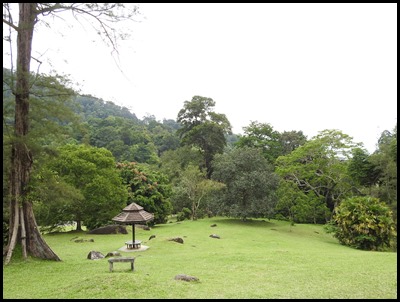Penang Botanic Garden

|
Penang Botanic Garden   Nearly at the Botanic Garden we stopped to enjoy the monkeys eating breakfast.
 Nearing the
Gardens.
  Lilies along the
way.
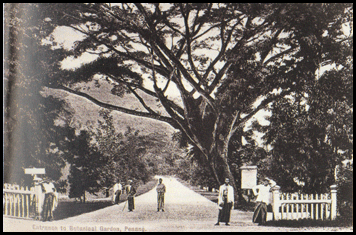  The entrance in 1900 and
today, Penang Botanic Gardens is a public
park situated on Jalan Air Terjun (Waterfall Road) in George
Town.
 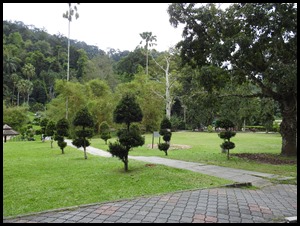 
We spotted a golf buggy type ‘bus’ and jumped on, just as well as although things started off on the flat, the road became incredibly steep.
Prior to the establishment of the present gardens, there were two previous botanic gardens in Penang - The Spice Gardens (1794–1806) and the Kitchen Gardens (1822–1834). George Town was established on Penang Island in August 1786; the settlement enabled the East India Company to establish a strategic base to challenge the Dutch spice trade and maritime supremacy in the Straits of Malacca. In 1794, the Company appointed Christopher Smith as botanist to establish the spice gardens. Smith, who had originally trained at Kew Gardens, planted a small garden of "20 orlongs" [10.5 hectares] in 1794 in the middle Ayer Itam valley and a larger garden, of "300 orlongs" [158 hectares], at Sungai Keluang. The exact location of both gardens is unclear.
In 1822, the then Governor of Penang, William Edward Phillips, established the second gardens, following the urging of Sir Stamford Raffles, the superintendent of the Singapore Botanic Gardens. Raffles' friend, the Danish naturalist Dr. Nathaniel Wallich, recommended the appointment of Penang Free School headmaster and amateur botanist, George Porter, on a salary of $100, to manage these gardens. Porter, formerly a member of the Calcutta Gardens staff, had accompanied Wallich to Singapore in 1822. Wallich had named a dwarf Dracaena, Dracaena porteri, after Porter. While Porter accepted the position of superintendent he was nominally in charge under a local judge, a Mr. Leycester, who was appointed curator. These gardens were also sited in the Ayer Itam valley; possibly on the same government land reserve as the previous gardens.
In 1884 Nathaniel Cantley, superintendent of the Singapore Botanic Gardens, established the present Botanic Gardens and appointed Charles Curtis as the assistant superintendent. At its inception, the Botanic Gardens Department was administered by the Gardens and Forests Department of the Straits Settlement. It was engaged mainly in the cultivation of commercial plants, inspecting crops and advising the planting community. When the work connected with economic crops and forestry were taken over by the Agriculture and Forestry Departments, Curtis made himself responsible for the layout of the Botanic Gardens and their transformation from an old granite quarry site. Under Curtis three "Experimental Gardens" were established, including the "Waterfall Nursery Gardens" (580 m) that was developed into the present Botanic Gardens, the "Top Hill Nursery" (777 metres) later renamed the "Government Bungalow Garden", and the "Plains Nursery" later comprising the Government Residency. Located at 579 metres, with an average annual rainfall in the 1890’s of 381 centimetres, the site of the Botanic Gardens embraces over 29 hectares, comprising a significant middle portion, of the Waterfall River valley below the Waterfall which cascades from a height of over 120 metres. The heavy rainfall often resulted in management problems, and land slips in the "steepest part of the grounds". The third Botanic Gardens were eventually sited in the Waterfall River valley on land acquired by the colonial government in 1884–85 for this purpose. Curtis records that much of this land was owned by a Mr Hogan. On his appointment as the first superintendent of the Botanic Garden, Curtis was presented with a tropical valley, including a nutmeg plantation with associated structures, and a prominent location on the trail to and at the foot of the "Great Waterfall". While an avid and acknowledged botanist and plant collector, he proved himself to be a creative landscape designer in crafting the design and development of the Gardens.
On accepting the position, Curtis proposed a long term strategy as to the development of the gardens and its potential role as a botanical repository and clearing house. Curtis' immediate actions were to develop a plant nursery and undertake a programme of works to create a pleasurable recreational and botanical garden in the valley. This vision was spelt out in detail in his 1885 annual report to Cantley as part of the Department's Annual Report. This included proposals to extend and develop the existing "Waterfall Gardens", the construction of road circuits, the erection of plant-houses for the propagation and cultivation of various species, and the provision of recreational venues. His immediate steps in 1885–86 were focused upon increasing the area of the Gardens in the valley together with improving road and pedestrian access. In his 1885 report, Curtis commented on "the poor gravelly soil in the valley" which required that considerable attention should be given to the preparation of the ground for tree planting. However, the "natural advantages of the surroundings, from a landscape gardening point of view ... in a great measure compensate for this defect." From the outset, Curtis introduced aesthetic considerations into the design of the Gardens, through the strategic placement of trees and the clearance of jungle. The circular road circuits he had constructed carefully weave through the valley opening up views, framing vantage points, and providing surprises to the visitor. Curtis' design was motivated by his objective to take advantage of and exploit the natural landscape in the first instance, and then locate plantings in functional or species family associations. A later supervisor, Frederick Sydney Banfield, observed of the planting design structure established by Curtis that: "There is little systematic arrangement even in the botanical sections, the principal aim having been to arrange the plants in such a way as to enhance the natural beauty of the Gardens". Curtis suffered from ill-health during his time as superintendent of the gardens, which he attributed to the quality and location of the accommodation made available to him. In March 1903, health problems caused him to take early long service leave and he formally retired on the 7th of December 1903, to be replaced by Walter Fox.
The Second World War took its toll on the Gardens. Although some of the Malay staff remained with the Gardens during the Japanese occupation, lack of funds and direction, together with the accumulation of war debris, left the Gardens in a very bad state. The Japanese excavated tunnels near the lily ponds and turned them into ammunition works and storage facilities, and a torpedo assembly station. Upon British reoccupation in 1945, much restoration and cleaning up had to be done. As part of the post war reorganisation, the Penang Botanic Gardens was separated from its parent establishment in Singapore and, in 1946, the Gardens administration passed from Singapore to the Federation of Malay States. Whilst under the direction of Frederick Sydney Banfield, the Botanic Gardens were restored to their original splendour. In 1956, the first Malaysian — Cheang Kok Choy — was appointed as curator of Gardens, where he had previously worked as a trainee gardener. He continued to carry out the policy laid down by his predecessors until his retirement in 1976.
1818 aquatint of the waterfall.
The waterfall and reservoir are private property although they can be visited by arrangement with the Penang Water Authority. Today, only a small proportion of the Penang water supply comes from the waterfall reservoir — approximately 10–15% of the population obtain their water from here, while most of the island's water supply comes from Sungai Muda, on the border of Penang and Kedah.
Our driver stopped just over half way, just past the reservoir – he
told us to follow a path and take pictures “In a very
pretty area.” At the end of the track we found a very
depressing pond.
 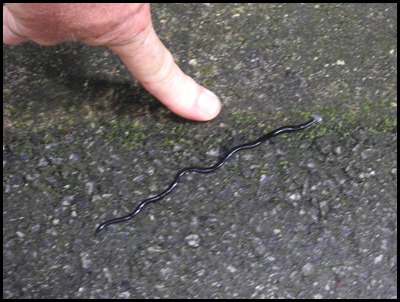 We saw a family bobbed down looking at
something black and shiny – with a silver hammerhead.
 The hammerhead is a flatworm. They come in many species not to mention shapes and sizes. They belong to a family called the Geoplanidae which are commonly known as land planarians. They are found in Asia, Australasia and also Europe and the Americas (where a number of species are considered invasive).
  
On the way back to the buggy we saw
a wall in bad shape, liked the
bins because they look like tree stumps but not the
signs.........
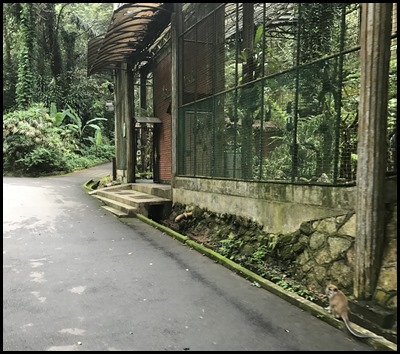 We popped out at the Orchid House – not a bloom in sight.
   We passed the
small bandstand and hopped out where we began, by the gate and found
a lovely garden.
 A very old tree
planted in 1929.
   We found some pretty yellows.
   Lovely. If
only the rest of the garden was at this standard.
 .............our
favourite fern.
 After a good bimble in the garden we
really liked we waited at the bus stop and watched birds
with great hair-dos
ALL IN ALL A BIG, HILLY AREA
BUT A BIT SAD IN PLACES
NICE VENUE BUT CLEARLY SOMEWHAT
RUNDOWN |
